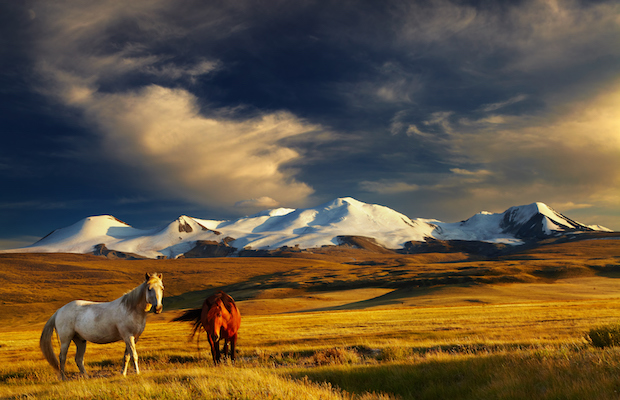Life in herder’s family
Be a member of an ordinary herder’s family, and you will understand their simple lifestyle, their amazing resourcefulness, and the mutual respect between man and nature. Enter their world not to ruled by written regulations where they herd their animals, raise their animals, raise their children, honour their wise and elderly, and transmit their values of empathy and courteousness. Then you will get a better understanding of what is going wrong in the modern sedentary civilization. Choosing a family from one of the minority tribes in Uvs, Kovd, or the other province on the western borders of Mongolia, you will fathom the depth of their unbroken traditions. We promise that this tranquil life will be a better recreation than any luxury holiday resort.
Traditional cuisine
There are special foods prepared and eaten together with cheerfulness. These meals consist wholly of meat. On a trip to the countryside, they will show you the real taste of meat while you smell the smoke of an open fire on the bank of a river. Eating khorkhog and boodog is very different from dining with knife and fork from porcelain plates, nibbling at something deprived of all original taste and appearance. It is very interesting to watch the Mongolian men leave their women to prepare the meat and chat at leisure, and collect stones on the riverbank with naked breasts in the fresh country air, then kindle a fire, growing lively and geting the food ready. Boodog is mostly made by skinning a marmot or a goat leaving the skin intact and filling it with peaces of the animal’s meat and glowing hot stones, while khorkhog is made in a churn, also with glowing hot stones and meat.
The Naadam
Naadam is held in summer when the flowers and the grass have spread. It is the nationwide festival with the most participants and spectators. On the face value, it is an amusement with three traditional kinds of tournaments: A race of six-year-old horses, wrestling, and archery. Grasping the full meaning of Naadam, however, implies a history and culture of broad conception and deep significance. Lily, a traveler from Australia, says, “Naadam is not just a series of competitions, but three days uniting sports, art, joy, merry-making, and vacation. But since there is no chance of seeing everything at one time, I have been coming to Mongolia for three years in a row. I have become fond of celebrating Naadam and eating khuushuur with the Mongolians in summer. On Naadam, I have seen Lily jumping in the stirrup to admire the strength of the Mongolian horses with their tiny riders, coming galloping from about 30 kilometres far, and the courage of the child jockeys. But I for myself prefer the Mongolian state Ceremony, the excitement of the people being glad at heart in the circle of their families, the khuushuur eaten and the airag drunk at Naadam, as well as the finery and manners of my compatriots
A cultural trip through the capital
If you want to get to an overview of the cultural heritage of Mongolia on a trip through the city of Ulan Bator, this is possible; of course, through you will only see a small selection from of the immense treasure chest filled during the history of the country. The Gandantegchinlen monastery, the centre of Buddism in Mongolia, can be reached or on foot, as can many museums and galleries throughout the city centre. Gandantegchinlen, or Gandan for short, is not only a place of worship where many believers bow to the 80 cubits-high Avalokiteshvara Buddha, but also the seat of the Buddist art academy of Mongolia and the main store of Mongolian Buddism’s cultural heritage. On a visit to the Bogd Khaan Palace Museum, you can discover many unique remains of Mongolia’s imperial and religious history, art, and culture, as well as the works of famous artisans and masters fo the relevant times. There are Buddha statues, objects of the late Jebtsundamba Khutugtu and his queen Dondogdulam. The Museum of National History and the Museum of Natural History are of course must see, but there are many other museums like the Military Museum of Mongolia, the G. Zanabazar Museum of Fine arts, the National Costumes Museum of Mongolia, the International Intellectuals Museum, and the Choijin Lama Temple
Museum
On the Path of Nomadic History If you wish to learn about the culture of the nomads, you must follow the path of the great history beginning in Ulaanbaatar. If you follow the itinerary UB-Khustai-Ungut-Yisunzuil-Shankh-Karakorum- Temeen Chuluu-Tuvkhun- Tsagaan Sumiin Tuur- Karabalgasun-Doit-Khushuu Tsaidam-Khar Bukhyn Balgas-Chintolgoi-Ulaan Kherem-Tsogtyin Balgas, you can see many kinds of monuments from the history and culture of the last two thousand years. Making a round trip of only 700 kilometers, you can experience the Orkhon valley, the hotbed of the wide Eurasian steppes. Traveling along this way, you will make a journey through the different landscapes and nationalities of Mongolia at the same time. You will feel the immense difference between the remains of the nomadic cities and settlements on one side and the European heritage on the other. Travelers on this route will not make an ordinary pleasure trip, but an intellectual experience. You may be lucky enough to discover the secret of why the nomads, though they seem to have been backward and underdeveloped for centuries, still lead a secure and happy life. You may find genuine freedom, unspoilt nature, and a meaningful life in this remote region of the earth.



 Anar
Anar 